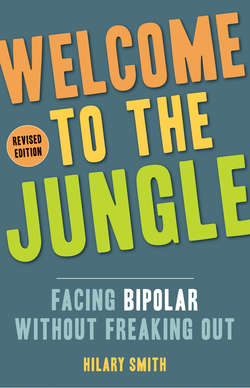Читать книгу Welcome to the Jungle, Revised Edition - Hilary T. Smith - Страница 23
На сайте Литреса книга снята с продажи.
2 MANIA, DEPRESSION, PSYCHOSIS, OH MY! A WHIRLWIND TOUR THROUGH THE EPISODES OF BIPOLAR DISORDER
ОглавлениеStates of human experience are extremely difficult to classify. Where does a mood end and a physical sensation begin? Where does a mental experience end and a spiritual experience begin? What's the difference between a bad mood and a bad day? Are some days just inherently sad or manic, or are “sad” and “manic” things that only happen inside individual people, and not in groups of people or in the wider world? Can a person be “depressed” or “manic” in a vacuum, or are those states in constant interplay with other people in the outside world?
Are you still “manic” if you feel really sad while you rearrange your furniture at three in the morning? Are you still “depressed” if you have two really bad days, then three really great ones, then two bad ones again? Is it still “psychosis” if you perceive your experience to be the result of intense yoga practice? Is it still “depression” if you have lots of energy and will to live, but feel overwhelming grief that they drained your favorite swamp to build a shopping mall?
These are all questions the Diagnostic and Statistical Manual of Mental Disorders (the book psychiatrists use to diagnose mental illnesses) does not get into. The DSM is all about putting human experiences into categories—drawing lines even where it doesn't make sense to draw them.
Think about a tree in the forest. It has bark and leaves and branches, which are obviously part of the tree. But what about the moss growing on the bark, and the ferns growing on the branches, and the mycelium intertwining with the roots, and the insects nesting in the wood? Are they part of the tree? Are they separate? Are they somewhere in between? A claim in either direction is very much up for debate. (The tree would die if you stripped off all the moss, or killed the mycelium—then again, can you really say that moss is part of a tree?)
Mood descriptions are no different. Take depression, for example. There's a feeling of sadness and a physical heaviness which are “obviously” part of being depressed. But your knee hurts from where you tore your meniscus, your job is entering data into a computer all day, and you hear cars and trucks driving past your house all the time, and you feel really, really down about that swamp. Are the cars and the job and the swamp part of your depression? Or is the feeling of sadness and the heaviness in your body the only part of depression that counts?
In this chapter, I am going to go through the DSM definitions of bipolar mania, depression, and psychosis because you are probably going to Google them anyway (don't lie!). But listen to me: even if some aspects of these descriptions sound familiar to you, don't let them overwrite the details of your personal experience. It's easy to read this stuff and say, “Oh yeah, I guess my mood lasted for four to seven days, and come to think of it, I did sleep less that month,” even when that isn't the whole story. There's a strong human impulse to identify with categories (that's why people get so obsessed with their astrological signs). At its worst extreme, the DSM can act as a script for “how to be bipolar” even if that's not how you experienced your moods before getting diagnosed.
So please keep perspective as you read this. Even if the DSM description of bipolar sounds just like you, don't lose sight of the moss and ferns and all the other unique details that make you you.
